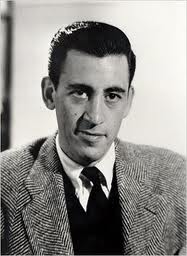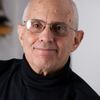
It is as inevitable as it is ironic: J. D. Salinger spends the entire second half of his life doing everything he can to stay out of the public eye (albeit, while filing and threatening lawsuits) is now everywhere: in a new documentary, a gargantuan biography, and even an entire Colbert Report. Most of the attention is on previously undisclosed aspects of his personal life, the revelation of forthcoming books, and a rehashing of the literary criticism, both adulatory and disparaging, that has attached like Lego bricks to his body of work.
I've been more interested in the author's role as a guru of sorts. In American Veda I asserted that "no literary figure can match the impact of J. D. Salinger on modern spirituality," and no one has challenged that statement. His later work is suffused with explicit Hindu and Buddhist teachings, which have informed and transformed millions of readers. I just reread swami Salinger's post-Catcher in the Rye books to prepare for a two-part webinar called "Literary Yoga: Whitman and Salinger as Writers and Seers," which I'm conducting with Cary Bayer, a Walt Whitman expert. As with most people who revisit cherished works of art, I responded to the stories differently than I did when I first discovered them more than 40 years ago.
For one thing, I can now see why many critics, including Tobias Wolff (author of This Boy's Life) on Colbert, disdain Salinger's Glass family tales as sermons. In Franny and Zooey and other tales, the author seems clearly to be on a mission. He wants to enlighten readers as the elder Glass brothers wish to enlighten their siblings. You can sense the youthful enthusiasm of a seeker who thinks he has found what he's been looking for and can't wait to share it. In the hands of a less skilled writer, that would come across insufferable proselytizing. In the hands of a master like Salinger, spiritual dilemmas seem as perfectly suited to his characters as jealousy does to Shakespeare's Othello. And Salinger's renowned ear for the speech patterns of mid-20th-century New Yorkers, and his eye for trenchant detail, help overcome the dangers of pedantry.
At least that's the case with most spiritual seekers and students of Vedanta (the Hindu philosophy to which Salinger was devoted), Zen Buddhism, Christian mysticism and other esoteric traditions the author draws from. To them, the spiritual references are not irritating sermons, but rather a realistic portrayal of the concerns of Salinger's characters. Often denigrated as self-absorbed neurotics, they are undergoing upheavals and transformations that spiritual aspirants identify with. Given the values of his characters, dialogue about mystical experience, karma, meditation, moksha (spiritual liberation) seems perfectly natural subjects of discourse.
His characters' dilemmas no doubt mirror Salinger's own as he strove to overcome the alienation and despair he knew as a sensitive young man and the existential quagmire that followed his shattering traumas in World War II. The Glass siblings see through the banality, absurdity, and emptiness of commonplace existence -- immortalized in Holden Caulfield's favorite epithet, "phony," in Catcher -- but they also sense that something more is possible for humans. That intuition of something more can make all the difference between embarking on an earnest spiritual quest and settling for mediocrity or wallowing in despair. It's not merely a matter of finding hope; a genuine spiritual path offers enough substantive knowledge and experience to reinforce the vision of possibilities. By all indications, that is what the young J.D. Salinger found at the Ramakrishna-Vivekananda Center of New York, an affiliation that continued long after he hunkered down in New Hampshire.
That long seclusion has been misconstrued as religious renunciation, probably because of his Vedantic orientation and his obvious disdain for material values. But Salinger was no cave-dwelling yogi. He had love affairs, stayed in touch with his friends and his kids, traveled, and otherwise participated in life as we know it, only quietly and privately. He was a classic hermetic writer, who went a giant step further by refusing to publish while he was still around to suffer the attention of a species he seemed to both adore and abhor.
In the new biographical information and my rereading of his post-Catcher stories, his deep ambivalence about the so-called "real world" leaped out. The Glass siblings struggle with it mightily, as did Salinger himself, no doubt. To one degree or another, so do most spiritual aspirants. Central to all mystical traditions is the teaching that every atom of creation is Divine. As Seymour Glass, the family guru, says, "all we do our whole lives is go from one little piece of Holy Ground to the next." Our task is to wake up to that numinous reality and behave accordingly. Seymour and the others have been teaching that to seekers for half a century.
But, as Salinger depicts with poignant clarity, it is no easy thing. While we might sometimes perceive people and things as Sacred, at other times the world is so annoying, pointless, and debilitating that the spiritual practitioner yearns to escape it. One foot in the world and one foot out: it's a two-step that aspirants dance while trying hard to maintain their balance. Shane Salerno, the Salinger biographer and documentarian now holding forth on the talk show circuit, says that his subject's family, upon his death, stated that the creator of Holden Caulfield was "in the world but not of it." The quote derives from the New Testament, but it expresses the goal of engagement without attachment to which every mystic and yogi aspires.
I doubt Salinger attained that ideal because very few do; but I hope he came close. And, if his belief in reincarnation was vindicated upon his passing, I hope he's on some other plane now, being amused, not annoyed, by all the attention he's getting.
